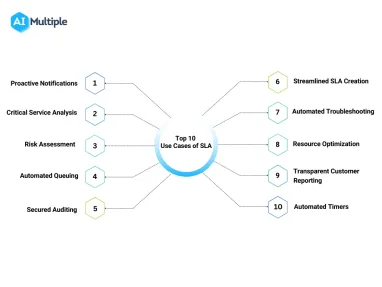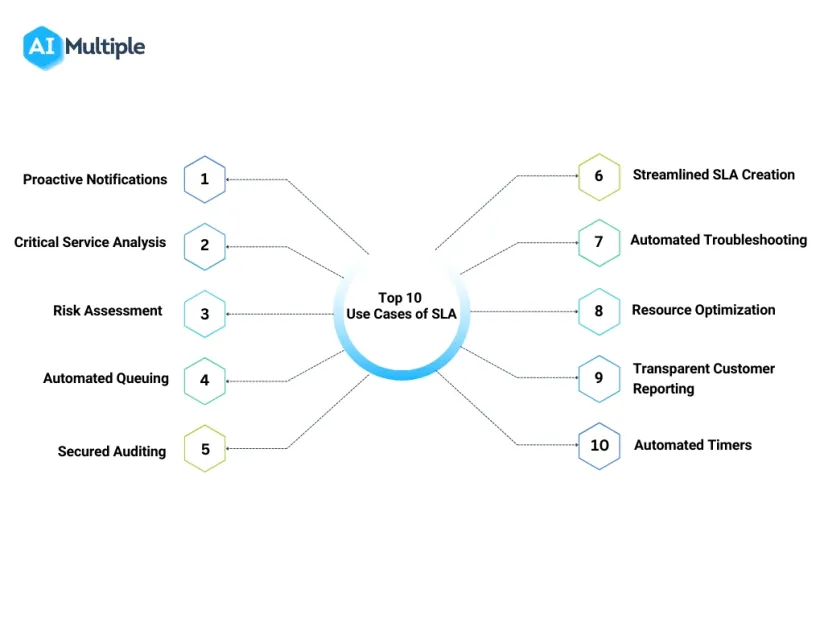Top 10 Use Cases of Service Level Agreement Automation in '24


Contracts are binding between companies and customers. So, an enterprise breaching its contract hurts its reputation and business. It is critical to constantly monitor the service level agreement (SLA) terms for contractual compliance.
But with different types of contracts, stipulations, and services, a manual service level agreement monitoring can be time-consuming, repetitive, and erroneous. Service level agreement automation can improve companies’ service level management via automated job scheduling and real-time breach alerts.
In this article, we explain what a service level agreement (SLA) is, how SLA is automated, and highlight the top 10 use cases of service level agreement automation.
What is a service level agreement (SLA)?
A service level agreement (SLA) is a contract/commitment between a company and a customer, laying out the:
- Service type
- Service delivery date, schedule, and requirement
- Other essential obligations
an enterprise agrees to provide. SLA compliance failure can have legal, reputational, and commercial ramifications for the organization.
What is service level agreement automation?
Service level agreement (SLA) automation is using a dedicated software to manage SLAs, such as:
- Conducting performance monitoring of jobs
- Getting the results
- Comparing results against the service level agreement thresholds
- Confirming conformance or lack thereof
- Notifying employees of (possible) breaches
For example, an alternative data provider has promised a marketing firm that it will send 1TB of social sentiment data by December 31. Bots can keep track of how much data has been sent to the client and compare that to performance metrics. If the amount sent by December 25th is 30% less than the SLA, the custom schedules of the software would warn the employees of a possible breach.
What are the use cases of service level agreement automation?
1. Proactive notifications
Document processing technologies can read the contract and extract useful data, such as the:
- Specific terms of the service level agreements
- Responsible department
- Customer’s information
RPA bots then create a performance monitoring dashboard for each SLA. After process mining tools extract the service level agreements’ event log data, RPA bots transport it to the dashboard for analysis.
If a process is behind schedule, a proactive alert email can be sent to the relevant department head. If the bottleneck can’t be fixed quickly, a progress report can automatically be sent to the customer, warning them of the delay in service.
2. Critical service analysis
Service level agreements can be granularly analyzed to achieve operational excellence. For example, a logistics company can monitor, log, and assess delivery times. This means critical service analysis of service level agreements lets firms assess and improve their performance.
3. Risk assessment
Service level agreement (SLA) monitoring can assist in risk assessment. For example, if a client churned after two negative support calls, alerts can be provided for a similar customer after one negative conversation.
A benefit of SLA automation is that ML tools can provide these information to customer reps instantly, so they don’t have to look for it.
4. Automated queuing
ML algorithms, business engines, and NLP tools can prioritize, and queue the breach tickets based on:
- Customer’s importance and past history
- The process priority
- The service level agreement’s deadline
The benefit is maximum flexibility for the company to optimize its resource allocation based on the breach’s importance and urgency.
5. Secured auditing
Cloud-based SLA automation solutions offer cloud management benefits:
- Revisions
- Change management histories Breaches, troubleshoots, and process performance data can, therefore, be stored and accessed on the cloud.
This is useful for compliance purposes, too. For example, airports are accountable federal regulators, such as the Federal Aviation Administration (FAA). And ESG metrics can be included in the SLA, with progress having to be communicated transparently and constantly. Cloud management improves data service quality in audits by providing a clear digital footprint of shortcomings, successes, operational changes, etc.
6. Streamlined service level agreement (SLA) creation
Especially for holding companies involved in different sectors, it can be difficult to pick and choose which service level agreements suit a customer from a certain industry. A service level agreement (SLA) solution can apply applicable SLAs to new customers based on their industry category and needed services.
The service level agreement solution can also enforce SLA exclusions. This is when the SLA should apply, but doesn’t (i.e., the company not sending a report during January because of Christmas vacation).
7. Automated troubleshooting
Developers can use job scheduling to define troubleshooting steps as soon as a breach in service level agreement (SLA) is identified. For example, a utility company might have promised to limit downtimes to thirty minutes. As soon as a network outage is detected, the RPA bots can orchestrate remote troubleshooting such as turning the power cell off and on. And if the downtime is reaching a particular threshold, field teams can be sent to location for recovery operations.
Learn more about RPA use cases in utility.
8. Resource optimization
One of the capabilities of service level agreement automation solutions is the analytics hub. The task mining feature of SLA management specifies the steps within an SLA task, the resources required, ticket priority, and estimated time of completion.
Based ticket priority and resource availability, firms can optimize how to use resources, like sending alerts to employees or concurrent bot deployment. The Orchestrator functionality, therefore, allows users to manage SLAs and troubleshooting tasks in a more data-driven manner.
The ML models can also leverage historical data to automatically allocate more resources to some jobs if they are historically seen as more likely to need supervision, and thus, viewed as a necessity.
9. Transparent customer reporting
B2C transparency is a necessity. Service level agreement automation can increase it. This is because the users have the ability to define and use the job scheduling capabilities to send an as-is report of SLA management to customers. This means the customers will have access to accurate performance reports where they will see the number of times a breach of contract has been made, when it’s been avoided, successful operations, and more.
Learn more about RPA use cases in reporting.
10. Automated timers
Whenever an SLA is to be done, the software can inform the employee of the time frame within which the task should be completed. When the job is done, the software will log the duration. Or the ML capabilities can use log data to suggest the appropriate duration time on a new SLA.
For more on process automation
To learn more about process automation, read:
- Process Automation Implementation: Guidelines & Best Practices
- 3 Types of Process Automation Tools
- 70+ Process Automation Tools: Guide to choose the right one
And to invest in a business process automation software, head to our BPA hub to find a data-driven list of vendors.
We will help you in the selection process:

Cem has been the principal analyst at AIMultiple since 2017. AIMultiple informs hundreds of thousands of businesses (as per similarWeb) including 60% of Fortune 500 every month.
Cem's work has been cited by leading global publications including Business Insider, Forbes, Washington Post, global firms like Deloitte, HPE, NGOs like World Economic Forum and supranational organizations like European Commission. You can see more reputable companies and media that referenced AIMultiple.
Throughout his career, Cem served as a tech consultant, tech buyer and tech entrepreneur. He advised businesses on their enterprise software, automation, cloud, AI / ML and other technology related decisions at McKinsey & Company and Altman Solon for more than a decade. He also published a McKinsey report on digitalization.
He led technology strategy and procurement of a telco while reporting to the CEO. He has also led commercial growth of deep tech company Hypatos that reached a 7 digit annual recurring revenue and a 9 digit valuation from 0 within 2 years. Cem's work in Hypatos was covered by leading technology publications like TechCrunch and Business Insider.
Cem regularly speaks at international technology conferences. He graduated from Bogazici University as a computer engineer and holds an MBA from Columbia Business School.
To stay up-to-date on B2B tech & accelerate your enterprise:
Follow on
Comments
Your email address will not be published. All fields are required.